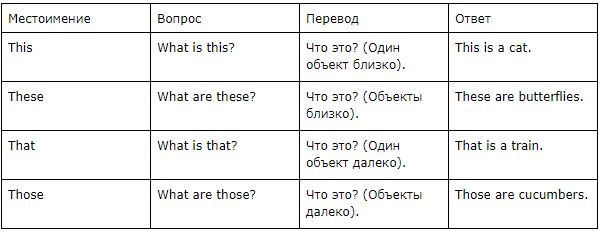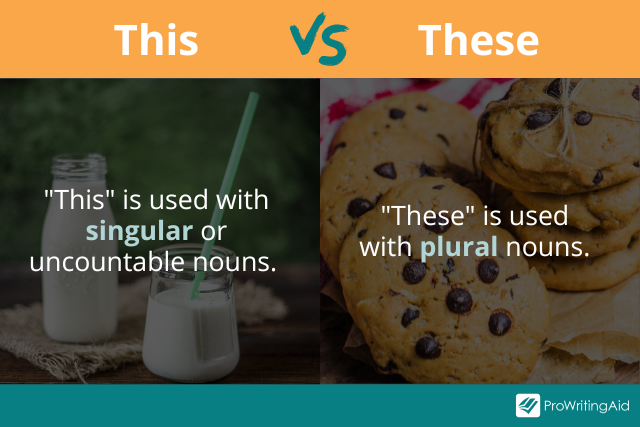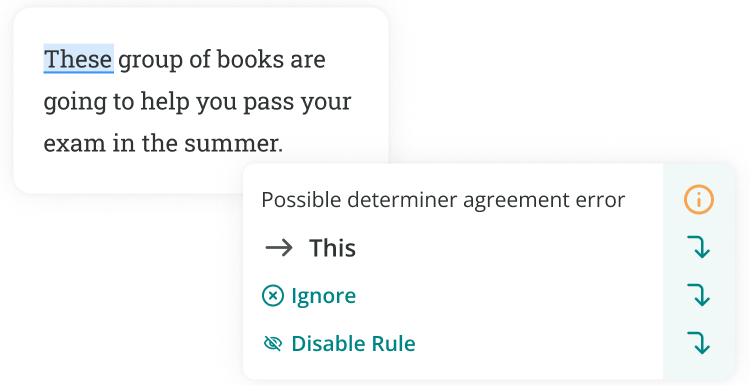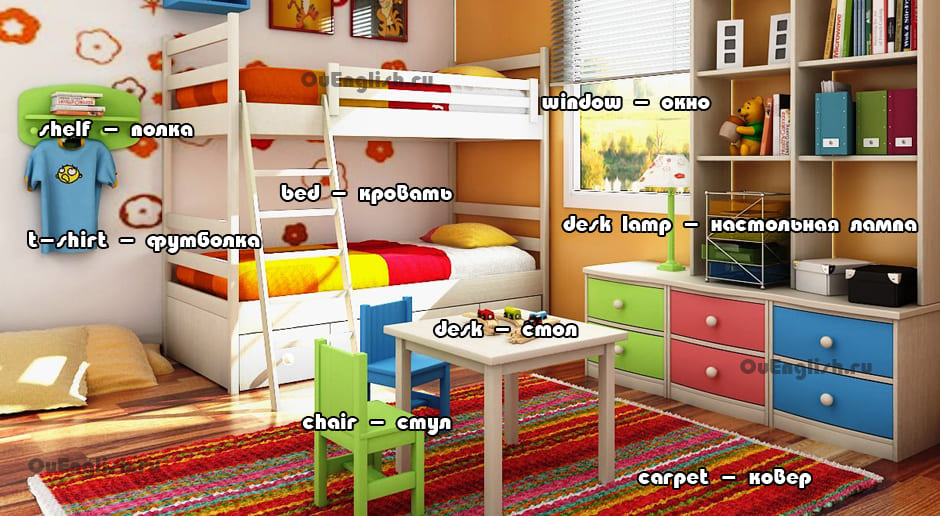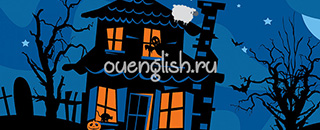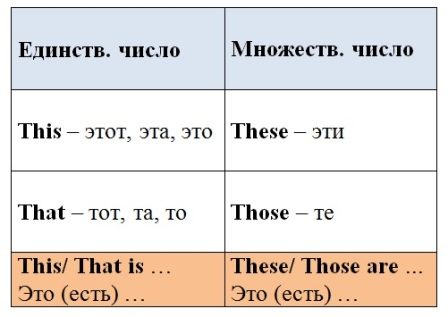This and that в английском языке
В английской речи и в художественных текстах часто встречаются слова that и this. Разница между ними, безусловно, существует, но какая — для многих остается загадкой.
Сегодня мы рассмотрим не только употребление this и that, но и грамотное использование местоимений these и those. Разница между этими парами довольно существенна, и, понимая ее, вы никогда больше не будете путать между собой слова that, this, those и these.
This or that: правило употребления
This и that — это указательные местоимения.
This переводится как этот/эта/это.
That, соответственно, как тот/та/то.
И то, и другое местоимение указывает на ОДИН предмет (или лицо), разница между this и that состоит в том, что объекты, которые мы обозначаем этими местоимениями, находятся на разном расстоянии от говорящего.
This обозначает то, что находится рядом, неподалеку, близко.
That — то, что расположено вдалеке, удаленно от говорящего.
Например,
This cat is mine. Эта кошка — моя.
That cat is yours. Та кошка твоя.
“Кошка” — это слово в единственном числе. Выбор this или that зависит именно от того, ГДЕ конкретно находится эта кошка. Та, что лежит возле моих ног — this cat. Та, что далеко от меня — that cat.
Когда мы говорим об удаленности объекта, речь идет не только о пространстве (физическое местоположение объекта — далеко или близко от говорящего), но и о времени.
Например:
That was awesome! I had a wonderful time!
Это было великолепно! Я чудесно провел время!
Действие имело место в прошлом, рассказчик сейчас вспоминает о приятно проведенном времени и употребляет местоимение that. Обратите внимание, на русский мы скорее всего переведем that как “это”, а не как “то” — в силу особенностей стилистики русского языка. Для нас разница между “этот” и “тот” в данном контексте незначительна. Но она принципиальна для английского языка. Употребить this в этом случае будет ошибкой.
Таким образом, рассказывая об отдаленных по времени событиях (действиях в прошлом), мы используем местоимение that.
This и that в живой речи
Часто путают this и that в диалогах, например, в телефонном разговоре.
Если вы представляетесь в беседе, используйте this:
— Hello. This is Mary.
Если вы задаете вопрос, уточняете, кто с вами говорит, используйте that:
— Is that Julia?
Сравните:
— Is that George?
— No, this is Mike.
These и those: разница и употребление
Помимо this и that часто можно встретить еще одну пару указательных местоимений: these-those. Правило их употребления звучит так: если предметов много, а не один, мы меняем this на these, а that на those.
These — эти
Those — те
These cats are mine. Эти кошки — мои.
Those cats are yours. Те кошки — твои.
Как видно, оба местоимения those, these указывают на множество объектов (кошек несколько). В чем между ними разница? These и those, так же, как и пара this–that, обозначают предметы, которые находятся на разном расстоянии от говорящего.
These — предметы близко (эти)
Those — предметы далеко (те)
Таким образом, выбирая подходящее местоимение, мы всегда смотрим только на два аспекта:
1. Количество предметов/лиц (сколько — один или много)
2. Их удаленность от говорящего (здесь или там)
Пара this–these используется в случае, если предмет/предметы — рядом с говорящим. Пара that–those употребляется, если объект или объекты далеко от говорящего.
Произносим правильно: these or this
Вы наверняка сталкивались с тем, что в живой речи трудно услышать разницу между these и this. Поэтому их часто путают и в речи, и на письме. Оба местоимения произносятся похоже, и в разговоре не всегда можно уловить, что же все-таки прозвучало — these или this. Как произносить these и this правильно:
This произносится кратко, при этом s на конце звучит как “с”, глухо.
А вот these произносится с долгим звуком “и” (как в русском «НИИ»), а на конце звучит “з”, а не “с”.
Если вы сами будете правильно произносить эти местоимения, то и в чужой речи услышите между ними разницу.
Как правильно употреблять this, that, these, those в предложении
Указательные местоимения this/that/these/those могут употребляться вместе с существительным либо без него. Взгляните:
Без существительного:
This is your last chance to see him.
Это твой последний шанс повидаться с ним.
С существительным:
This meeting is your last chance to see him.
Это собрание — твой последний шанс повидаться с ним.
Если указательные местоимения стоят в начале предложения, и после них нет определяющего существительного, то, как правило, далее следует глагол to be в форме единственного или множественного числа:
This is / These are/ That is/ Those are
This is a cat. — Это кошка.
These are butterflies. — Это бабочки.
That is a train. — Это поезд.
Those are cucumbers. — Это огурцы.
И this, и that выполняют здесь функцию подлежащего и переводятся как “это”.
Указательные местоимения без существительных могут появляться в различных частях предложения:
Which trousers would you choose, these or those?
Какие брюки ты бы выбрал, эти или те?
What is that?
Что это там?
Если указательное местоимение предшествует существительному, его функция — указать на конкретный объект:
This cat has drunk our milk. — Эта кошка выпила наше молоко.
В данном случае местоимение this уточняет, что именно эта кошка, а не какая-то другая, выпила все молоко.
Любое из четырех указательных местоимений может сопровождаться существительным:
This flower smells great. — Этот цветок пахнет великолепно.
That man is very angry. — Тот человек очень злой.
These tickets cost too much. —Эти билеты стоят слишком дорого.
Those presents are from my friend. — Те подарки — от моих друзей.
Каверзный вопрос “Что это?”
Когда вы задаете вопрос “Что это?”, вы можете столкнуться с трудностью. Ведь, произнесенный по-русски, вопрос “Что это?” одинаково звучит, сколько бы объектов ни было и где бы они ни находились. Взгляните:
Из-за того, что по-русски вопрос во всех четырех ситуациях звучит одинаково, многие путаются, как же правильно спрашивать по-английски: “Что это?”.
Ориентируйтесь на удаленность объекта и количество объектов. Определили? Теперь выбирайте подходящее местоимение и соответствующую форму глагола to be.
Указательные местоимения и one
Иногда после указательных местоимений можно встретить слово one. А то и ones. Что это такое?
Случается, что для сохранения красоты речи нужно избежать повторения существительного. Например:
This T-shirt is too expensive. That T-shirt is cheaper.
Эта футболка слишком дорогая. Та футболка дешевле.
Повторение слова “футболка” здесь не оправдано. Зачем? В русской речи мы скорее сказали бы так: “Эта футболка слишком дорогая. Та — дешевле”. Каждому понятно, что “та” = “та футболка”.
В английском языке происходит нечто похожее. Так же, как и в русском, мы избавляемся от дубля слова T-shirt. Но если в русском языке можно оставить местоимение “та” в гордом одиночестве, то в английском мы должны подобрать для существительного заменитель. Эту функцию берет на себя слово one. Взгляните:
This T-shirt is too expensive. That one is cheaper.
Эта футболка слишком дорогая. Та дешевле.
Так как речь идет об одном предмете, мы использовали указательное местоимение в единственном числе — that. После местоимений that/this правило предписывает использовать слово one.
Если же мы говорим о множестве предметов и используем местоимения these и those, то в качестве замены существительного мы будем использовать ones.
These glasses are awful! Pass me those ones, please.
Эти очки ужасные. Передай мне те, пожалуйста.
Распространенная ошибка: не надо пытаться переводить one и ones. Ни как “один”, ни как “одни”, ни как-либо еще. В данном случае one/ones — это кирпичик, который позволяет грамотно строить предложение с точки зрения структуры, на русский язык ни one, ни ones в подобных предложениях не переводятся.
Теперь вы знаете, когда нужно использовать указательные местоимения this, that, these, those и можете грамотно строить свою речь. Читайте другие статьи Puzzle English и совершенствуйте свой английский!
When deciding on which demonstrative to use in front of the word ‘information’ you would choose to use ‘this’ instead of ‘these’. This is because the word ‘these’ is reserved for plural nouns while ‘this’ is used in front of singular nouns.
The English language can be somewhat tricky at times. Continue reading further to learn more about the words ‘this’ and ‘these’, and examples of how to use each.
Both of the words ‘this’ and ‘these’ are both pronouns. Pronouns are words used in place of other nouns. She, he, it, this, and these are all examples of pronouns. The specific pronouns ‘this’ and ‘these’ both refer to nouns that are similar in space and time.
This and that are also demonstrative words. Demonstratives are words that we use in sentences to indicate nouns. They draw attention to other nouns that are close or far in time and place. Demonstratives distinguish between a car and this car. These, those, that, and this are the four most prevalent demonstratives in the English language.
This
The pronoun ‘this’ is a singular noun that is close in time or space. This is also used for uncountable nouns that are singular. When using the word ‘this’ in a sentence it must be followed by a singular noun. Some examples of sentences that use the word ‘this’ are
- This dog needs to be washed because it smells.
- I didn’t know that you needed this one.
- We were told that this river had flooded recently.
- My sister made pancakes this morning.
- Our new year’s resolution this year is to visit every park in the city.
These
The word ‘these’ is another demonstrative but it is used as a pronoun for plural nouns. Without a plural noun after this word, the sentence cannot be grammatically correct according to the English language. Some examples of using the pronoun ‘these’ are
- I didn’t know these flowers bloomed in the fall.
- These cars do not get good gas mileage.
- Do you know if these are the correct glasses?
- Where should I put these shoes?
- I think this shirt is too large for me.
This Information or These Information
Because the word information is singular(and uncountable), you will use the pronoun ‘this’ in front of it. Keep in mind that the word ‘information’ will almost always be singular and therefore this rule will not change.
- Author
- Recent Posts
Conor is the main writer here at One Minute English and was an English teacher for 10 years. He is interested in helping people with their English skills and learning about using A.I tools at work.
This and these are demonstratives, which means they indicate a specific noun in a sentence. They’re both important words in the English language.
Many people mix up this and these because they both refer to nouns that are near in space and time.
So what exactly is the difference between this vs these?
The short answer is that this is used with singular or uncountable nouns (e.g. this egg), while these refers to plural nouns (e.g. these cookies).
This article will explain the difference between this vs these and help you remember how to use these words correctly in your writing.
Quick Definition and Meaning of “This”
This refers to a singular noun that is near in time or space, such as a lamp or a desk.
If you say “I know this song,” for example, you’re most likely talking about the song that’s currently playing within earshot.
We also use this for uncountable nouns that we treat as singular, such as water, sugar, or happiness. For example, you might say “This water tastes funny” to talk about the water you’re currently drinking.
This is often used with words describing time, such as morning, week, and year. When used with these words, this can be used to talk about time in the present or in the near past or near present. For example, you could use the phrase “this afternoon” to refer to the afternoon of the present day.
It’s also important to remember that when the noun is omitted after this, it becomes a singular pronoun. If you say “I enjoyed eating this,” the word this refers to whatever singular dish you just ate.
Quick Definition and Meaning of “These”
These also refers to nouns that are near in time or space, but it is used for plural countable nouns. The noun that follows these must always be plural.
If you say “I don’t know any of these people,” you’re referring to more than one person, all of whom are near in time or space.
Just like this, these can be used as a plural pronoun if you omit the noun afterwards. If you say “Wow, I like these,” the word these most likely refers to whatever plural noun you’re referring to in the present moment.
What’s the Difference Between This and These?
The main difference between this and these is that this is used to refer to singular and uncountable nouns, while these is used to refer to plural countable nouns.
You would say “this necklace” to refer to a single necklace, and “these necklaces” to refer to multiple necklaces. It would be incorrect to say “these necklace” or “this necklaces.”
Let’s take a look at some more examples of how to use this and these in a sentence.
Examples of These in a Sentence
Here are some examples of these used to refer to a plural countable noun:
- Where did these papers come from?
- Let me hand you these boxes.
- These musicians are talented.
- These shoes are really beautiful.
Here are some examples of these used as demonstrative pronouns, with the noun omitted:
- These are organic.
- Let me give you these.
- What are these?
- I don’t want any of these.
One of the best ways to learn a word is to see examples from literature in the real world. Here are some examples of these from popular English books:
- “Some of these women have had so much work done their words come out all mushy because they can’t move their lips.”—Maggie Shipstead, Great Circle
- “The long route took us through all these old neighborhoods and shopping streets and finally past a tiny little temple in the middle of a bunch of ugly concrete office buildings.”—A Tale for the Time Being
- “But these days, inside my closet, poetry is as real to me as an ax. I need it more than food.”—Amity Gaige, Sea Wife
- “But the nostalgia didn’t hit. These weren’t my memories.”—Ottessa Moshfegh, My Year of Rest and Relaxation
- “Places like these were already suffocating. It did naught to add more weight upon the pillow pressed to their faces.”—Chloe Gong, These Violet Delights
- “These are the times that try men’s souls.”—Thomas Paine, The American Crisis
Examples of This in a Sentence
Here are some examples of this used to refer to a singular noun or uncountable noun:
- This cupcake is delicious. (singular noun)
- I told my parents that I want this necklace for Christmas. (singular noun)
- What is this music you’re listening to? (uncountable noun)
- Get a grip on all this anger. (uncountable noun)
Here are some examples of this used to talk about time:
- My friends called me this morning. (near past)
- What’s for dinner this evening? (near future)
- I had three cancellations this week. (present)
- This year has been difficult for my family. (present)
Here are some examples of this used as demonstrative pronouns, with the noun omitted:
- Don’t forget to turn this off when you leave.
- Can you please heat this on the stove over a low flame?
- This is delicious!
-
I like this.
Finally, here are some examples of this from popular English books:
-
“This morning I had poison for breakfast.”—Lemony Snicket, Poison for Breakfast
- “She stared at him as though he were another architectural marvel of this strange new world.”—Shelley Parker-Chan, She Who Became the Sun
- “Was I alive? I hoped so, but only because if this was the location of the afterlife, I’d be lodging an appeal immediately.”—Gail Honeyman, Eleanor Oliphant Is Completely Fine
- “The kids stared at me, awestruck. Why had their parents not explained this to them? Probably because they didn’t understand it themselves.”—Andy Weir, Project Hail Mary
- “This is my first experience of a heartfelt apology from Marcus, and so far it has involved six clichés, two butchered literary references and no eye contact.”—Beth O’Leary, The Road Trip
Conclusion on This vs These
There you have it—a complete guide to this vs these. Here’s a quick recap:
- Use this to refer to singular nouns that are near in time and space
- Use these to refer to plural nouns that are near in time and space
- Both this and these can be used as pronouns if you omit the noun afterwards
If you’re worried about mixing up this and these, you can always run your work through ProWritingAid, which will show you which one is correct. Our grammar checker will point out confused words and misspellings.
We hope this article helped you learn the difference between these two words!

- Главная
- Английская грамматика. Грамматика английского языка онлайн.
- Оборот This is и These are в английском языке
Оборот This is используется, когда мы хотим указать на какой-либо предмет.
What is this? This is a cup. Что это такое? Это чашка.
This is an interesting book. Это интересная книга.
This is a nice grey furry cat. Это красивый, серый, пушистый кот.
This is a red desk lamp. Это красная настольная лампа.
Если вам надо указать на несколько предметов, то используйте оборот These are.
These are dogs. Это собаки.
These are interesting books. Это интересные книги.
These are stolen paintings. Это украденные картины.
These are the keys to the apartment. Это ключи от квартиры.
Выполним упражнение. Назовите обозначенные предметы на картинке с помощью оборота This is, These are.
Посмотреть ответы к упражнению
Похожие материалы:
English story
Random Word
Cousin — Двоюродный брат
Noun
I’m calling my cousin.
Я звоню дворюродному брату.
В этом уроке вы познакомитесь с английскими указательными местоимениями this и that. Эти местоимения имеют форму единственного и множественного числа.
ПРИМЕРЫ
This boy is my brother. – Этот мальчик – мой брат.
Take these apples. – Возьмите эти яблоки.
I don’t like that dress. – Мне не нравится то платье.
I didn’t see those girls yesterday. – Я не видел тех девушек вчера.
Указательные местоимения this, these, that, those (для начинающих)
ПРИМЕРЫ
Hello! This is Olga. — Is that Julia? — Это Ольга. — Это Джулия? (в телефонных разговорах).
We had a lot of rain that summer. — В то лето было много дождей.
I hope he will come home by that time. — Я надеюсь, он придет к тому времени.
Это книга. — This is a book.
Это книги. — These are books.
What does this mean? – Что это означает?
Is that so? – Это так?
That’s all right. – Правильно.
Указательные местоимения this, these, that, those. Упражнения
Упражнение 1. Поставьте существительное в множественное число.
1. This cup is dirty. 2. That pie was tasty. 3. This is good hotel. 4. There is a children’s playground in the park. 5. That is a new supermarket in our town. 6. This is a lemon ice-cream for tea. 7. This is a nice dress for my niece. 8. This man is a banker. 9. That woman is my sister. 10. This child is my son. 11. That goose is big and white. 12. This mouse is grey. 13. This man is my uncle. 14. That woman is my cousin. 15. There is a girl playing in the garden.
Упражнение 2. Переведите на английский язык.
1. Это ребенок. Это дети.
2. Это мальчик. Это мальчики.
3. Это девочка. Это девочки.
4. Это птица. Это птицы.
5. Это животное. Это животные.
Упражнение 3. Поставьте следующие предложения во множественное число.
1. This is a bird. 2. Is that also a bird? — No, it isn’t. That is a cat. 3. Is that a good horse? — Yes, it is. 4. Is that cow big or small? — It is big. 5. This is an apple and that is a flower. 6. Where is the coin? — It is in the box. 7. What colour is the box? — It is green. 8. What is it made of? — It is made of wood. 9. What is that man? — He is a clerk. 10. Is he in the office? — Yes, he is. 11. Is that woman a nurse? — No, she isn’t. — What is she? — She is a doctor. 12. Is his brother at home? — Yes, he is. 13. This house has a balcony. 14. This building is quite modern. 15. This is a new district of St. Petersburg. 16. There is a shop, a cinema and a theatre in the new district. 17. He is a worker. 18. I am a doctor. 19. We hear a child’s voice. 20. She is a nice girl.
Указательные местоимения this, these, that и those. Упражнения с ответами
Сегодня поработаем над указательными местоимениями. Упражнения на this / that, these / those помогут вам раз и навсегда разобраться в теме указательные местоимения в английском. Я подобрала несколько несложных упражнений для детей и парочку посложнее для взрослых. Упражнения на this, that, these и those идут в порядке возрастания сложности. В конце статьи вы найдете ответы на большинство упражнений.
This, that, these, those упражнения.
Упражнение 1. Circle the correct word.
- this /these shoes
- this / these trousers
- this / these socks
- this / these shorts
- this / these trainers
- this / these hat
- this / these dress
- this / these blouse
- this / these skirt
- this / these scarf
- this / these boots
- this / these tights
Упражнение 2. Choose the correct word.
- This / These trousers are black.
- That / Those shirt is very nice.
- That / Those shoes are comfortable.
- This / These skirt is old.
- This / Those T-shirt is my brother’s.
- That / Those T-shirt is very small.
Упражнение 3. Write in this or these.
- Take _______ trousers.
- Take _______ sweater.
- Don’t take _______ bag.
- Don’t take _______ shorts.
- Take _______hat
- Take _______scarf.
- Don’t take_______ boots.
- Take _______ shoes.
Упражнение 4. Составь и запиши предложения. Make sentences.
Упражнение 5. Circle the right word.
- This /These is a car.
- That / Those are planes.
- Those /That is a whale.
- That / Those are sharks.
- This / These is my guitar.
- That / Those is an island.
Упражнение 6. Insert the correct word.
- This __________ is easy. a) questions b) homework
- These ___________ are my neighbors. a) women b) man
- What are you doing ________ afternoon? a) that b) this
- Who’s ________ speaking? a) this b) it
- These are my glasses and ________ are hers. a) those b) that
- We are going to the seaside __________ summer. b) this a) that
- __________ man over there is a famous politician. b) These a) That
Упражнение 7. Insert this, that, these, those.
- None of _______ present expressed any surprise on hearing __________.
- Try one of _____________.
- _________ is a computer
- ___________ are the TV sets of the latest type.
- Suddenly I felt something soft and warm on my knees. _________ was a cat.
- Whom were you talking with? ________ was a friend of mine.
Упражнение 8. Fill in the gaps with this, that, these, those.
- _________ people over there are waiting for the bus
- The day I first came to London was wonderful. I will remember _______day for ever.
- ______ summer I’m pretty busy.
- I’m working as a receptionist _______days.
- ________ were the days!
- Do you remember _______ winter when we all went to Egypt?
- Hello!__________ is Alan. Can I speak to Harry, please?
- _________ is a new cathedral and _________ one over there was built 900 years ago.
- Will you come over at five o’clock? I’ll be at home at _________ time.
- The summer of 1999 I spent in the country. I remember we had a lot of rain _______ year.
- _________ are my sisters. They have just arrived from London.
- Who was ________ girl I saw you with last night?
- Do you want to sit on ______chair here or on ________ one over there?
- _________ sweets you gave me last night were very nice.
- Look at _______ colourful air balloons in the sky!
- Clyde and Nancy have decided to buy a house ______ year.
- _________ trees over there were planted by the pupils of our school
- ______ buildings just in front of you were erected in the 18th century.
- Hello, Mrs Swift.________ is Mr Willis from Globe &Co speaking
- I wish I would have bought ______ woolen sweater last Sunday.
- You’d better take ________ The others we saw don’t match your dress.
- I couldn’t forget_________ beautiful girl I had met in the park.
- Do you know ________ little boy? He says he has been lost in the shop
- Can you reach ________ old books on the top shelf?
Упражнение 9. Write answers to the questions.
Example: Whose watch is this? (Linda) This is Linda’s watch
- Whose books are these? (the pupils)
- Whose house is this? (John)
- Whose offices are these? (the bankers)
- Whose flowers are these? (my mother)
- Whose translation is this? (my friend)
- Whose shoes are these? (my sister)
- Whose stamps are these? (Ted)
- Whose fields are these? (the farmers)
- Whose discovery is this? (Newton)
- Whose duties are these? (the pupils)
- Whose words are those? (our teacher)
Упражнение 10. Напишите эти предложения во множественном числе.
This is a cat. These are cats.
- That is a car
- This is a dog
- That is a star.
- This is his pencil
- That is his pen.
- This is a sheep.
- That is a child.
Упражнение 11. Translate into English paying attention to the use of demonstrative pronouns.
- Это были самые красивые розы, какие я когда-либо видел.
- Посмотрите, кто это? — Это один из наших студентов.
- Я где-то видел этого человека. — Это один из наших спортсменов. — Да, теперь я узнаю, это он
- Кто там? — Откройте, это я.
- Какие это были чудесные цветы!
Ответы к упражнениям на указательные местоимения.
1 these, 2 these, 3 these, 4 these, 5 these, 6 this, 7 this, 8 this, 9 this, 10 this, 11 these, 12 these
1 these, 2 that, 3 those, 4 this, 5 this, 6 that
1 these, 2 this, 3 this, 4 these, 5 this, 6 this, 7 these, 8 these
Your own sentences.
1 this, 2 those, 3 that, 4 those, 5 this, 6 that
1 b, 2 a, 3 b, 4 a, 5 a, 6 b, 7 b
1 those / that, 2 these или those, 3 this или that, 4 these или those, 5 that, 6 that
1 those, 2 that, 3 this, 4 these, 5 those, 6 that, 7 this, 8 this /that, 9 that, 10 that, 11 these, 12 that, 13 this /that, 14 those, 15 those, 16 this, 17 those, 18 these, 19 this, 20 that, 21 these, 22 that, 23 this. 24 those
Понравилось? Сохраните на будущее и поделитесь с друзьями!
3 Комментариев для «Указательные местоимения this, these, that и those. Упражнения с ответами»
Указательные местоимения this, that, these, those в английском языке
Сегодня мы разберем указательные местоимения в английском языке: this, that, these, those. Эти местоимения указывают на объект, который имеет в виду говорящий человек. Этот объект может находиться близко или далеко. Так же объект может быть один, а может быть много. Разберемся в каких случаях, какой из местоимений использовать.
Указательные местоимения this, these в английском языке
This указывает на предмет (ед. число), который находится в непосредственной близости от говорящего. То есть, если предмет находится так близко, что мы можем до него дотянутся рукой, то в таком случае используется местоимение this.
This is a pan. — Эта ручка.
Например в данный момент я держу эту ручку у себя в руках.
This is a book. — Эта книга.
Книга лежит на столе в непосредственной близости от нас(я могу до нее дотянуться и взять в руки).
These указывает на предметы (мн. число), которые находятся в непосредственной близости от говорящего.
These are pans. — Эти ручки.
These are books. — Эти книги.
Указательные местоимения that, those в английском языке
Местоимение that указывает на предмет, который находится вдали от говорящего. То есть мы не можем дотянуться до предмета рукой.
That is a pan. — Вон та ручка.
That is a book. — Вон та книга.
Those используется по тому-же принципу, что и that, только с множественным числом.
Those are pans. — Вон те ручки.
Those are books. — Вон те книги.
Как вы видите, использование указательных местоимений в английском языке, довольно простая тема.
Источники: http://englishinn.ru/this-these-that-those-v-angliyskom-yazyike-dlya-nachinayushhih.html, http://grammar-tei.com/ukazatelnye-mestoimeniya-this-these-that-i-those-uprazhneniya-s-otvetami/, http://ouenglish.ru/difficult/this-that-these-those-english


